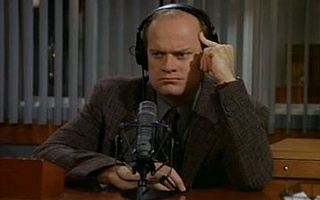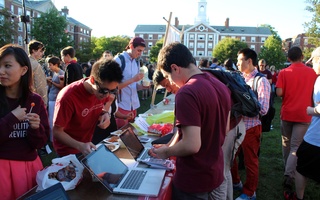As the staff of The Crimson is well aware, involvement in extracurricular activities on campus can necessitate a significant commitment of time and effort. Some faculty members have expressed concern over the time and energy students at Harvard are spending outside the classroom; the opportunity cost, they argue, is a more intense, fulfilling, and informative academic experience. The nation was shocked to learn that the median grade at Harvard is an A-, a statistic that many interpret, rightly or wrongly, to mean that Harvard is too easy—that the attention of its students must be focused elsewhere.
While grade inflation is a complex issue, we would not be so quick to discount the role that extracurricular activities can play in shaping young minds—indeed, as the cliché goes, in “teaching students how to think.” For while student groups function largely without faculty oversight, there are things one can learn in a play, during a debate round, or through service in the Phillips Brooks House Association that simply are not teachable in the classroom.
Whether that learning is about teamwork, leadership, perseverance, or a specific subject area, students in organizations have a unique set of motivations: to win a competition, display a skill, feel a sense of belonging. The members of Harvard’s highly successful Fed Challenge team, for example, work hard in part because they are interested in macroeconomics and monetary policy and in part because they want to remain national champions. In their own ways, organizations like the Anscombe Society, which advocates for abstinence from pre-marital sex and against same-sex marriage, and Munch, a discussion-based group for students interested in BDSM, provide safe and supportive forums for conversations that might otherwise not be had. The passion of individual student groups often spills over into the College community as a whole. The Kuumba Singers of Harvard College, whose music expresses black artistry and spirituality, put on performances that are educational as well as impressive. The incredible success of the men’s basketball team in recent years also highlights how the dedication of a handful of students can excite the entire student body, helping to foster the sense of community that is so important at a liberal arts college.
Given the positive impact student group membership has on the undergraduate experience, the University should play an active role in removing financial barriers to participation. We were disappointed that Undergraduate Council representatives’ call for an additional $250,000 in funding fell on deaf ears. UC President Gus A. Mayopolous ’15 has called the approximately $500,000 UC budget significantly smaller than budgets at other schools. For instance, the student government budget at Georgetown is nearly double the UC’s. Predictably, a gradual stretching of the UC budget, which was last increased eight years ago, has resulted in diminished funding for club sports: The maximum subsidy has fallen from $2,000 to $1,275, and some teams have been forced to raise fees or enact spending cuts. With a $32 billion endowment and a president whose total compensation hit the $1 million mark in 2012, we think the $250,000 request is more than fair. The University is committed to making a Harvard education affordable to all; it should commit to making the full Harvard experience accessible and affordable as well.
Budget constraints have become a problem in part because of the large number of campus student groups, now at 399. And even that number excludes Harvard’s 65 club sports teams and 86 PBHA-affiliated service groups. On the surface, a broad array of extracurricular options is a positive. As Harvard admits an increasingly diverse set of students, it seems only natural that an increasingly diverse set of talents and interests be represented on its extracurricular landscape. But there may be some more pernicious factors at play. If students are compelled to form new, redundant organizations because they feel excluded from those that exist already, then the growth of student groups may reflect a deeper cultural problem at Harvard, one that sometimes takes the form of intense elitism and competition. We are also concerned about pre-professional pressure felt by students, who feel they must be a president or a treasurer in order to land a summer internship or job post-graduation.
Organizations like Veritas Financial Group, the Harvard College Consulting Group, and Harvard Undergraduate Women in Business have an obvious pre-professional slant. Student publications provide a journalistic experience impossible to replicate in the classroom. Clubs like the Entrepreneurship Forum and Hack Harvard teach valuable entrepreneurial and technical skills.
But just because a skill cannot be taught in a lab or lecture does not mean it is not worth learning. We hope the undergraduates who participate in pre-professional clubs are gaining real expertise. Even managing the finances or travel schedule of a club with no connection to a particular professional field can teach skills that may be very useful in one’s eventual career. Of course, membership in certain organizations may serve simply as a signal of interest to employers. If a student who would prefer to play Quidditch or compete at a poetry slam foregoes a passion in order to add a more vocationally minded line to a resume, then that is a shame.
And so we offer guarded support for efforts to fund and sustain the diverse slate of student groups at Harvard. We believe firmly in the importance of keeping a robust set of extracurricular activities accessible to all members of Harvard’s community. As such, we condemn the administration for refusing to grant the UC’s request for additional funding. And although we remain worried about the role that Harvard’s culture of elitism and competitiveness has in the undergraduate experience, we hope that the diversity of student groups—pre-professional and otherwise—represents a healthy variety of interests and increased opportunities for students to feel included.
Read more in Opinion
A Step Toward Responsible InvestmentRecommended Articles
-
Not Just SchoolworkAs Commencement approaches, my roommate and I have spent a lot of time discussing how Harvard student life has changed ...
-
City Council Discusses Cambridge's Extracurricular Activity OfferingsPointing out that the days of playing pick-up baseball after school are long gone, officials from the Cambridge City Council and the Cambridge Schools Committee discussed ways to enrich Cantabrigian students’ extracurricular lives at the Council’s weekly meeting Monday night.
-
The Gravity of ExtracurricularsExtracurricular life at Harvard is certainly rich, but also intense, time demanding, and not insulated from pre-professional pressures.
-
Does Harvard Place Enough Value on Academics?Reality check: It is impossible for anyone to dictate exactly how anyone else should spend his time.
-
 Harvard's Greatest Characters, at Harvard
Harvard's Greatest Characters, at Harvard -
 The Extra-Curriculum
The Extra-Curriculum













